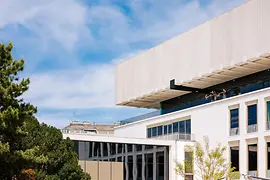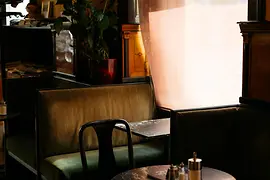Vienna Press Release – December 2023 Reopening of the Wien Museum: where history meets the future
It’s the most spectacular opening of a Vienna museum this year. The completely renovated and expanded Wien Museum has been open to visitors again since December 6, 2023. Opened in 1959, the building has recently been struggling with a lack of space and was in urgent need of refurbishment. The Austrian team of architects Certov, Winkler + Ruck spent four years modernizing the building from top to bottom and adding a spectacular upper floor. A cube made of exposed concrete now “floats” above the original building. “This design was my favorite out of the 274 submissions right from the outset,” says Director Matti Bunzl, “I am so impressed with how the architects have managed to construct a second building around the existing one. The idea of a building within a building is ingenious in its simplicity.”
Free admission to the Wien Museum
The opening of the new Wien Museum also marks a first in Vienna: the permanent exhibition is open to the public free of charge. This is a move that follows the British model; in the UK, admission to national museums has been free since 2001. The Wien Museum is the first public museum in Austria to adopt this approach. There are also numerous free programs for students, children and families.
The new permanent exhibition “Vienna. My History” presents the city’s history from the Neolithic Age to the present day across three floors and 3,300 square meters using 1,700 objects. Bunzl said, “The permanent exhibition covers the official history of the city. To be entrusted with such a project is an honor and at the same time a challenge. The museum’s collection is vast, the city’s history is rich and complex, and the stories to be told are many and varied.”
The suspended floor offers plenty of space for unusual temporary exhibitions for which visitors will need a ticket. The museum has planned some world-class exhibitions for 2024. “Fischer von Erlach. Design of a historical architecture” (from February 1) showcases the baroque master builder in a contemporary context. “Secessions. Klimt, Stuck, Liebermann” (from May 23) presents the artistic geniuses who had a significant influence on the emergence of modernism at the turn of the 20th century in Vienna, Munich and Berlin.
“trude & töchter” dining concept
An open space has been created between the old and new buildings, which will be used as a terrace floor. It offers spectacular views of Karlsplatz and the surrounding area. This floor houses a café, an event center and educational studios. A glass pavilion was added to the entrance area to welcome visitors like an outstretched hand. The museum restaurant “trude”, which is named in honor of the Viennese photographer Trude Fleischmann (1895-1990) and serves modern Viennese cuisine, is also located in the entrance area. The café-bar on the terrace floor and its balcony is called “& töchter”. The museum’s larger exhibits are displayed in the new great hall, including the original figures from the Donnerbrunnen fountain, a five and a half meter tall model of St. Stephen’s Cathedral, the Prater whale “Poldi” and many more.
Lively Karlsplatz
Anyone visiting the new Wien Museum should definitely also take the time to discover its exciting surroundings: Karlsplatz and the adjacent Gußhausviertel. The Vienna Tourist Board is dedicating 2024 to “Heartbeat Streets. Vienna’s vibrant neighborhoods”. This scheme aims to lift the curtain on Vienna’s most authentic neighborhoods. Karlsplatz is the gateway to the Gußhausviertel, a typical inner-city Gründerzeit neighborhood. An urban space that bustles with life around the clock for young and old alike. Permanent culinary offerings and cultural institutions as well as numerous events are very popular, especially the Art Advent Christmas Market, which is known for its unique arts and crafts and certified organic food, and the multi-day Popfest Wien, where local musicians bring the square to life every year in July with free admission. The iconic landmark on Karlsplatz is the Karlskirche church, which was completed in 1739. With its enormous green dome and opulent interior, it is considered the epitome of Baroque architecture and one of the most beautiful monuments in Vienna.
A wonderful Viennese neighborhood awaits just beyond Karlskirche: the Gußhausviertel in Wieden, the 4th district. It is a densely populated city center Gründerzeit district with beautiful architecture and numerous former palaces that is home to a number of embassies and foreign delegations. It is located between some of the city’s most important landmarks and is flanked by Karlsplatz, the Belvedere and Vienna Central Station. The main artery of the neighborhood is Argentinierstraße, which offers a view of the free-standing Elisabethkirche. It is one of the busiest cycle routes anywhere in Vienna. It is scheduled to be converted into a bicycle lane in fall 2024. The entire width of the road will then be devoted to cycling, and it will also be landscaped and traffic-calmed.
Restaurant tour through the Gußhausviertel
Many of the neighborhood’s culinary highlights are clustered around the intersection with Gußhausstraße, which is also the location of the eponymous former Gußhaus (the imperial and royal cannon foundry). Buchecker & Sohn, Wiener Wiazhaus and the recently reopened Gasthaus Artner on Wieden all serve superb Viennese cuisine. The Gußhausviertel also has a cosmopolitan feel. Popular venues include the bistronomy restaurant Z’Som, the Gorilla Kitchen (a hybrid of café, bar and restaurant), the aperitivo bar Casolaro Bros, the wine bar Wein & Kunst and the delightful Carl Ludwig Cafe, which can be found in the garden of the Palais Erzherzog Carl Ludwig.
The ORF RadioKulturhaus in the Funkhaus Wien, a listed building from the interwar period, and the Theater Akzent, which was opened at the end of the 1980s and was designed in a postmodern architectural style, offer cultural opportunities in the Grätzel. Anton Benya Park is a popular green oasis in the neighborhood, which was recently modernized and made more climate-friendly. Heading towards the Central Station, there is a Viennese coffee house institution in the adjacent Elisabethviertel that is well worth a visit: Café Goldegg. Here visitors can enjoy specialty coffees, typically Viennese coffee house cuisine and pastries served amidst a beautiful interior with wall paneling, dark green plush upholstery, brass chandeliers and much more.
More information:
Contact
Helena Steinhart
Media Relations
+43 1 211 14-364
helena.steinhart@vienna.info











